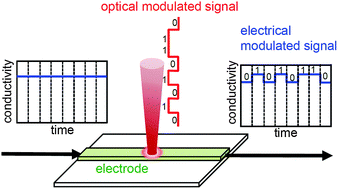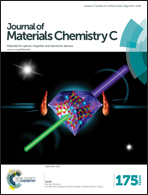Photoactive conducting polymers with light-driven conductivity modulation: dual functionality for simple circuits†
Abstract
We report on light-driven conductivity modulation in highly conductive organic polyaniline films, which exhibit dual functionality as an electrode and an optical-to-electrical signal transducer. The new light-driven conductivity modulation (LCM) agent consists of primary and secondary dopant-mimic groups for maintaining the high electrical conductivity of polyaniline. In addition, a push–pull-type azo-stilbene group with a fast photoisomerization rate is incorporated into the LCM agent for reversible photo-induced dipole moment switching and dominant absorption of pump light. The photoactive polyaniline films mixed with the LCM agent maintain a high electrical conductivity of over 102 S cm−1 and the electrical conductivity is reversibly modulated in a simple lateral two-electrode structure using sequential ON–OFF illumination of visible light, with a large modulation amplitude of up to roughly 0.8 S cm−1. The photoactive polyaniline films exhibit high photochemical stability and fast modulation rates without requiring additional erasing light. Therefore, these photoactive, highly conductive polymers with dual functionality are very important potential materials for low-cost optoelectronic devices with a simple device structure.


 Please wait while we load your content...
Please wait while we load your content...